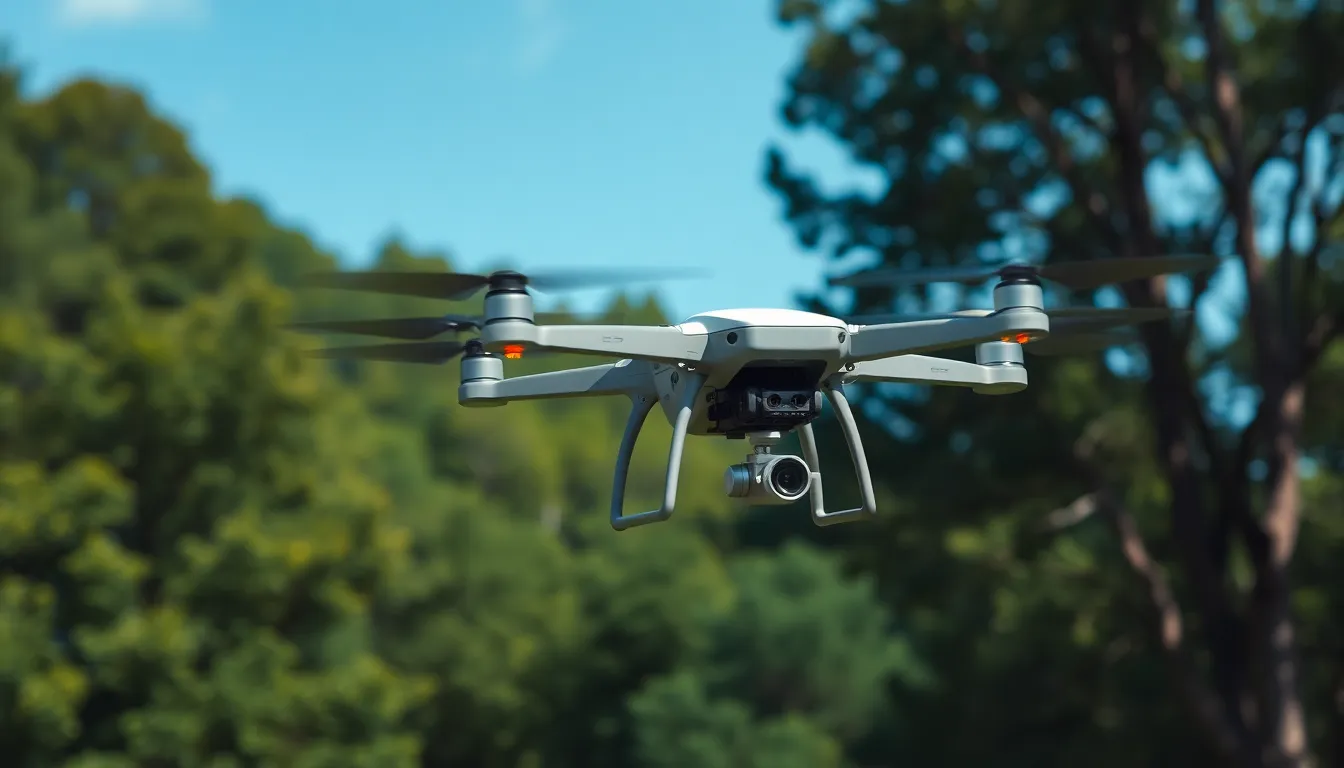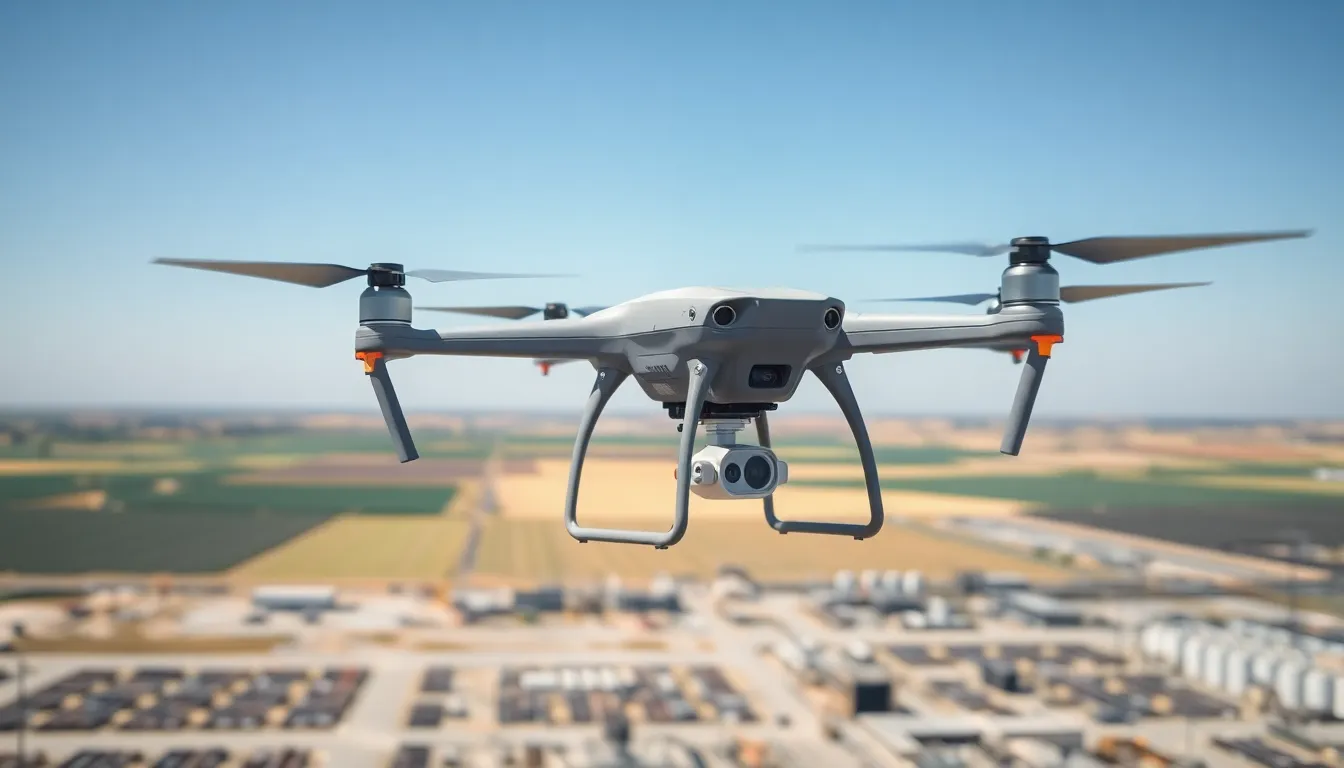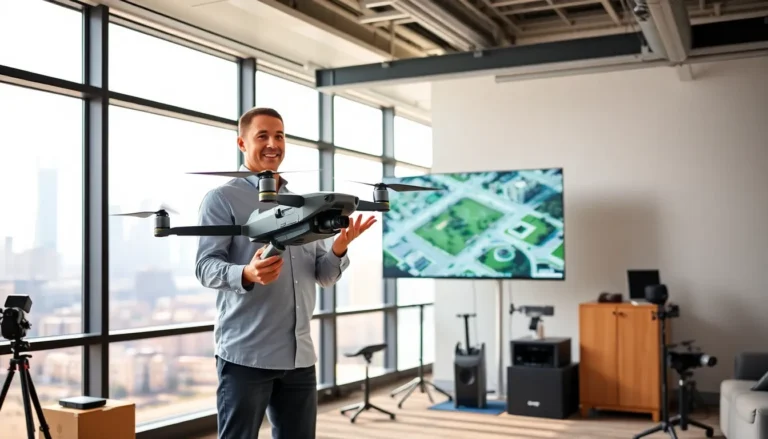In a world where technology is evolving faster than a caffeinated squirrel, drones with chemical sensors are taking center stage. Imagine a flying gadget that can sniff out hazardous chemicals while you sip your coffee—sounds like a scene from a sci-fi movie, right? But it’s very real and revolutionizing industries from environmental monitoring to disaster response.
Table of Contents
ToggleOverview of Drones With Chemical Sensors
Drones equipped with chemical sensors perform real-time analysis of the environment. These devices identify hazardous chemicals at concentrations as low as parts per million. In industrial settings, drones can monitor air quality, ensuring compliance with safety regulations.
Environmental monitoring becomes more efficient with the deployment of these drones. They gather data over large areas, reducing the need for extensive ground surveys. Real-time data allows for rapid response to chemical spills or leaks, minimizing potential harm to ecosystems.
In disaster response scenarios, drones with chemical sensors prove invaluable. These technologies survey affected areas, providing critical information about toxic substances. First responders benefit from accurate assessments, aiding in evacuation or cleanup efforts.
Various industries, like agriculture and oil and gas, increasingly rely on these sensors. In agriculture, drones monitor crop health by detecting pesticide residues, fostering sustainable practices. For oil and gas companies, drones track gas leaks, enhancing safety measures.
Researchers continue to innovate, enhancing the capabilities of chemical sensors. Advanced technologies yield smaller, more sensitive sensors, capable of identifying a broader range of chemicals. This evolution leads to improved data accuracy and reliability in crucial applications.
Drones equipped with chemical sensors represent a transformative advancement in technology. Applications span multiple sectors, promoting environmental safety and public health. Their growing presence indicates a trend towards integrating aerial surveillance with advanced sensor technology.
Applications of Drones With Chemical Sensors

Drones with chemical sensors offer significant advantages in various fields due to their precision and efficiency. These applications enhance safety and data collection capabilities.
Environmental Monitoring
Drones excel in environmental monitoring as they gather extensive data across large areas quickly. They identify hazardous chemicals in the air and provide real-time analysis, detecting substances at concentrations as low as parts per million. Environmental agencies rely on these data points to assess air quality and identify pollution sources with accuracy. Their ability to monitor remote and hard-to-reach locations reduces the reliance on cumbersome ground surveys, making it easier to track environmental changes over time. In cases of chemical spills, drones facilitate rapid response, minimizing ecological damage and aiding in recovery efforts.
Industrial Safety
In industrial safety, drones play a crucial role in ensuring compliance with safety regulations. Companies use drones to monitor air quality within facilities, detecting harmful emissions that may pose health risks to workers. Real-time data collected helps organizations respond immediately to potential threats, enhancing overall workplace safety. Furthermore, drones are instrumental in assessing storage tanks for gas leaks, providing an efficient alternative to manual inspections. Businesses in the oil and gas sector find these sensors invaluable as they enhance safety measures and reduce the likelihood of accidents. Overall, drones with chemical sensors contribute to safer work environments through continuous monitoring and immediate alerts.
Advantages of Using Drones With Chemical Sensors
Drones with chemical sensors offer numerous advantages across multiple industries, enhancing operational efficiency and safety.
Enhanced Data Collection
Real-time data collection characterizes drones with chemical sensors. These devices collect extensive environmental data quickly, identifying harmful chemicals in the air with pinpoint accuracy. Coverage spans large areas, enabling agencies to monitor remote locations that traditional methods find challenging to access. Multiple sensors operating simultaneously allow for comprehensive analysis, producing results within minutes. Enhanced data collection improves decision-making for environmental agencies and industrial operators, ensuring adherence to safety regulations and timely interventions in emergency situations.
Cost-Effectiveness
Deploying drones significantly reduces operational costs associated with traditional monitoring methods. Ground surveys typically involve extensive labor and time, but drones accomplish similar tasks more efficiently. Maintenance costs for aerial systems remain lower than for ground-based equipment, while safety inspections become less hazardous. Using drones minimizes personnel exposure to hazardous environments, drastically reducing risk and associated liability. Organizations benefit from fewer accidents and streamlined operations, promoting further investment in aerial surveillance technologies. This economic advantage highlights the practicality of incorporating drones into standard operational procedures across various industries.
Challenges and Limitations
Drones with chemical sensors face several challenges and limitations that impact their effectiveness. These obstacles include technical constraints and regulatory issues.
Technical Constraints
Technical constraints hinder the performance of drones equipped with chemical sensors. Sensor sensitivity may limit detection capabilities, especially for highly volatile compounds. Battery life restricts flight duration, reducing the area drones can cover in a single mission. Additionally, payload weight affects the number of sensors a drone can carry, impacting data collection efficiency. Interference from environmental factors such as wind or precipitation can reduce data accuracy. Communication issues can also arise, particularly in remote areas with limited connectivity. Addressing these constraints is essential for maximizing the utility of drones in environmental monitoring and safety applications.
Regulatory Issues
Regulatory issues present significant hurdles for the deployment of drones with chemical sensors. Compliance with aviation laws is mandatory, as various countries maintain strict airspace regulations. These regulations often limit flight altitude and operational radius. Privacy concerns also arise, especially if drones collect data over private properties. Agencies often require extensive permits, which may delay project timelines. Engaging with local authorities prior to deployment can facilitate smoother operations. Understanding and navigating these regulatory landscapes remain crucial for organizations intending to utilize these advanced technologies effectively.
Future Trends in Drones With Chemical Sensors
Innovations in drones with chemical sensors are set to transform various industries even further. Enhanced sensitivity of future sensors will improve detection capabilities, enabling precise identification of hazardous substances. As battery technology advances, longer flight times will allow drones to cover larger areas without needing frequent recharges.
Integration of artificial intelligence is another promising trend. Smart algorithms will analyze collected data in real-time, enhancing decision-making processes for emergency responders and environmental agencies. Continuous data streaming from drones to centralized databases will facilitate quicker assessments and more accurate responses.
The potential for regulatory advancements also exists. As authorities recognize the benefits of drones equipped with chemical sensors, streamlined permitting processes might emerge, reducing deployment delays. Future regulations could support broader usage while ensuring safety and privacy.
Emerging markets like urban air mobility will benefit from these advancements. Drones may monitor urban environments for air quality, providing crucial data to city planners and health officials. Industries focused on environmental sustainability will increasingly adopt drones, supporting initiatives aimed at reducing pollution and enhancing compliance.
Research into miniaturization will lead to smaller, more cost-effective drones. Such devices can penetrate difficult-to-reach areas, improving data collection in hard-to-access locations. Price reductions may further drive adoption across various sectors, making advanced monitoring technology more accessible.
Collaboration between tech companies and environmental organizations will likely accelerate innovation. Partnerships may focus on developing new applications and enhancing existing ones, broadening the impact of this technology. Ultimately, the future of drones with chemical sensors appears bright, with significant advancements on the horizon that promise to enhance safety, efficiency, and environmental protection.
Drones equipped with chemical sensors are revolutionizing how industries approach safety and environmental monitoring. Their ability to swiftly gather and analyze data makes them invaluable in responding to hazardous situations. As technology advances these drones will become even more efficient and effective.
The integration of artificial intelligence and improvements in sensor technology promise to enhance their capabilities further. This evolution will not only streamline operations but also significantly bolster public health and safety.
With ongoing innovations and potential regulatory improvements the future looks bright for drones in this field. They’re set to play a crucial role in protecting ecosystems and ensuring compliance across various sectors.





